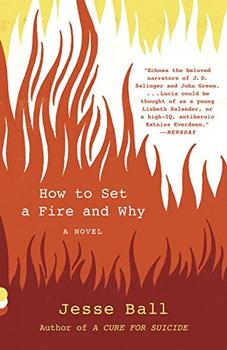 In How to Set a Fire and Why, Lucia claims to not remember exactly what occurred during an argument with her aunt's landlord, leaving her exact reasoning and motivation somewhat mysterious. In writing Lucia as an unreliable narrator, Jesse Ball draws from an established tradition.
In How to Set a Fire and Why, Lucia claims to not remember exactly what occurred during an argument with her aunt's landlord, leaving her exact reasoning and motivation somewhat mysterious. In writing Lucia as an unreliable narrator, Jesse Ball draws from an established tradition.
An unreliable narrator lies, expresses uncertainty or bias, or seems to have a misunderstanding of situations that occurred. The author may employ an unreliable narrator to intentionally mislead the reader or as a means of characterization. Part of the pleasure in encountering such a narrator is parsing out what is true and what is not. Teen and young adult narrators are some of the most obvious and well-known examples of the trope, and this makes logical sense. Adolescence is often a time of conflict, teenagers vacillate between uncertainty and confidence in their beliefs as they try to forge a concrete identity for themselves. They are often dishonest, caught as they are between childhood and adulthood, they push the limits, break the rules and lie to avoid punishment.
 Lucia and J.D Salinger's hero Holden Caulfield from The Catcher in the Rye share a similar worldview. He constantly complains of "phonies" and she expresses disdain for her peers and the values of those around her. While being punished for fighting at school she finds herself in the main office, describing it as a room full of "enemies." Holden and Lucia also punctuate their account with hallmark phrases of unreliability like "I think," "I guess," and "I don't know" and make up elaborate stories to entertain themselves.
Lucia and J.D Salinger's hero Holden Caulfield from The Catcher in the Rye share a similar worldview. He constantly complains of "phonies" and she expresses disdain for her peers and the values of those around her. While being punished for fighting at school she finds herself in the main office, describing it as a room full of "enemies." Holden and Lucia also punctuate their account with hallmark phrases of unreliability like "I think," "I guess," and "I don't know" and make up elaborate stories to entertain themselves.
 A more extreme case can be found in Anthony Burgess' A Clockwork Orange where a teenager named Alex narrates his vicious acts of "ultraviolence" and subsequent "treatment" while in prison for murder. Alex is unreliable because he is an unrepentant psychopath committing horrible acts. While Lucia exhibits violent behavior and may show some signs of a possible mental disorder, it's not possible with the information given to form an accurate diagnosis. Both characters drink and use drugs, another obvious source of unreliability. After ingesting unknown pills with friends, Lucia writes a diary entry titled "What Did We Do?" in which she attempts to recall the events of the night before.
A more extreme case can be found in Anthony Burgess' A Clockwork Orange where a teenager named Alex narrates his vicious acts of "ultraviolence" and subsequent "treatment" while in prison for murder. Alex is unreliable because he is an unrepentant psychopath committing horrible acts. While Lucia exhibits violent behavior and may show some signs of a possible mental disorder, it's not possible with the information given to form an accurate diagnosis. Both characters drink and use drugs, another obvious source of unreliability. After ingesting unknown pills with friends, Lucia writes a diary entry titled "What Did We Do?" in which she attempts to recall the events of the night before.
 Another example of the young, mentally ill unreliable narrator is found in Shirley Jackson's We Have Always Lived in the Castle in which eighteen-year-old Merricat Blackwood veers wildly between charmingly eccentric and downright schizophrenic behavior. Merricat and Lucia share a painful family history and a penchant for setting fires.
Another example of the young, mentally ill unreliable narrator is found in Shirley Jackson's We Have Always Lived in the Castle in which eighteen-year-old Merricat Blackwood veers wildly between charmingly eccentric and downright schizophrenic behavior. Merricat and Lucia share a painful family history and a penchant for setting fires.
Lucia finds a more contemporary kindred spirit in the protagonist of Eileen by Ottessa Moshfegh. Though a little bit older, on her return to the family home, Eileen clearly suffered some arrested development. She and Lucia have a similarly unstable home life, a shared sense of humor, violent fantasies, and similar patterns of disorder. Eileen has an eating disorder and obsessive/compulsive issues, while Lucia acts on compulsion and can't control her temper. Both characters are on a collision course with crime.
These examples establish the adolescent psyche as a natural breeding ground for unreliable narration. Readers are consistently fascinated with these characters, misanthropes fueled by hormones and rebellion, acting without the benefit of fully formed brains and personalities. How much can we trust them? As with real teenagers, who knows!
This article first ran as the "Beyond the Book" feature for Jesse Ball's How to Set a Fire and Why. Every time BookBrowse reviews a book we go "beyond the book" to explore a related topic, such as this article by Lisa Butts. Most of these articles are only available to our members, but at any given time, a sampling can be found on our homepage and, from time to time, we reprint one in this blog.